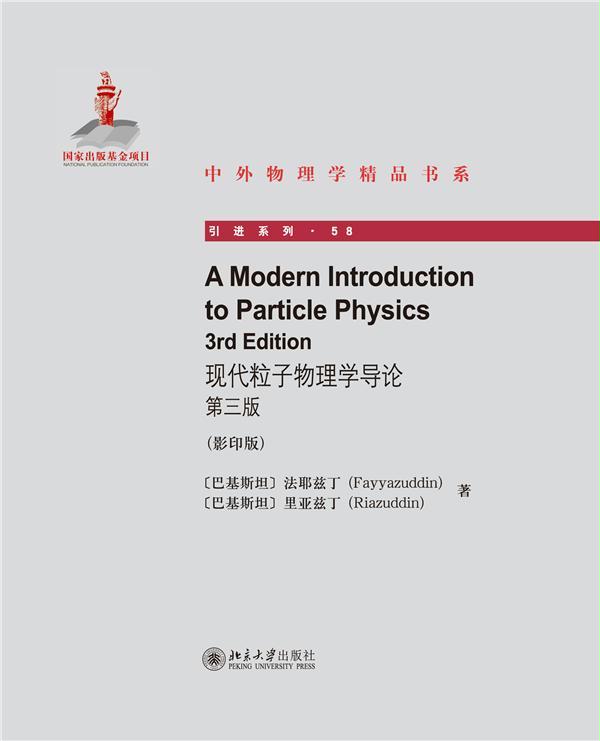《現代粒子物理學導論(第三版)(英文影印版)》是2014年出版的圖書,作者是法耶茲丁等。
基本介紹
- 書名:現代粒子物理學導論(第三版)(英文影印版)
- 作者:法耶茲丁
- ISBN: 978-7-301-25174-4
- 頁數:684
- 定價:¥116.00
- 出版時間: 2014-12-29
- 裝幀:平
- 開本:16開
主要內容,出版背景,作者簡介,
主要內容
現代粒子物理學導論(第三版)(英文影印版)
書號: 25174
作者: (巴基斯坦)法耶茲丁等 版次: 1
字數: 683 千字
瀏覽次數: 299
叢書名: 中外物理學精品書系
出版背景
本書涵蓋了粒子物理各種方向,包括量子電動力學、夸克模型、標準模型等等。在理論和實驗兩方面都進行了系統講解。此外,本書還著重討論了天體物理、宇宙學和粒子物理學的交叉研究,即天體粒子物理學。 本書適合粒子物理、核物理、天體物理等領域的研究者和研究生閱讀。
章節目錄:
Preface vii
1. Introduction
1.1 Fundamental Forces
1.2 Relative Strength of Four Fundamental Forces
1.3 Range of the Three Basic Forces
1.4 Classi_cation of Matter
1.5 Strong Color Charges
1.6 Fundamental Role of \Charges" in the Uni_cation of Forces
1.7 Strong Quark-Quark Force
1.8 Grand Uni_cation
1.9 Units and Notation
1.10 Problems
1.11 References
2. Scattering and Particle Interaction
2.1 Introduction
2.2 Kinematics of a Scattering Process
2.3 Interaction Picture
2.4 Scattering Matrix (S-Matrix)
2.5 Phase Space
2.6 Examples
2.7 Electromagnetic Interaction
2.8 Weak Interaction
2.9 Hadronic Cross-section
2.10 Problems
2.11 References
3. Space-Time Symmetries
3.1 Introduction
3.2 Invariance Principle
3.3 Parity
3.4 Intrinsic Parity
3.5 Parity Constraints on S-Matrix for Hadronic Reactions
3.6 Time Reversal
3.7 Applications
3.8 Unitarity Constraints
3.9 Problems
3.10 References
4. Internal Symmetries
4.1 Selection Rules and Globally Conserved Quantum Numbers
4.2 Isospin
4.3 Resonance Production
4.4 Charge Conjugation
4.5 G-Parity
4.6 Problems
4.7 References
5. Unitary Groups and SU(3)
5.1 Unitary Groups and SU(3)
5.2 Particle Representations in Flavor SU(3)
5.3 U-Spin
5.4 Irreducible Representations of SU(3)
5.5 SU(N)
5.6 Applications of Flavor SU(3)
5.7 Mass Splitting in Flavor SU(3)
5.8 Problems
5.9 References
6. SU(6) and Quark Model
6.1 SU(6)
6.2 Magnetic Moments of Baryons
6.3 Radiative Decays of Vector Mesons
6.4 Radiative Decays (Complementary Derivation)
6.5 Problems
6.6 References
7. Color, Gauge Principle and Quantum Chromodynamics
7.1 Evidence for Color
7.2 Gauge Principle
7.3 Non-Abelion Local Gauge Transformations (Yang-Mills) .
7.4 Quantum Chromodynamics (QCD)
7.5 Hadron Spectroscopy
7.6 The Mass Spectrum
7.7 Problems
7.8 References
8. Heavy Flavors
8.1 Discovery of Charm
8.2 Charm
8.3 Strong and Radiative Decays of D_ Mesons
8.4 Heavy Baryons
8.5 Quarkonium
8.6 Leptonic Decay Width of Quarkonium
8.7 Hadronic Decay Width
8.8 Non-Relativistic Treatment of Quarkonium
8.9 Observations
8.10 Tetraquark
8.11 Problems
8.12 References
9. Heavy Quark E_ective Theory
9.1 E_ective Lagrangian
9.2 Spin Symmetry of Heavy Quark
9.3 Mass Spectroscopy for Hadrons with One Heavy Quark .
9.4 The P-wave Heavy Mesons: Mass Spectroscopy
9.5 Decays of P-wave Mesons
9.6 Problems
9.7 References
10. Weak Interaction
10.1 V ?? A Interaction
10.2 Classi_cation of Weak Processes
10.3 Baryon Decays
10.4 Pseudoscalar Meson Decays
10.5 Hadronic Weak Decays
10.6 Problems
10.7 References
11. Properties of Weak Hadronic Currents and Chiral Symmetry
11.1 Introduction
11.2 Conserved Vector Current Hypothesis (CVC)
11.3 Partially Conserved Axial Vector Current Hypothesis (PCAC)
11.4 Current Algebra and Chiral Symmetry
11.5 Axial Anomaly
11.6 QCD Sum Rules
11.7 Problems
11.8 References
12. Neutrino
12.1 Introduction
12.2 Intrinsic Properties of Neutrinos
12.3 Mass
12.4 Neutrino Oscillations
12.5 Evidence for Neutrino Oscillations
12.6 Neutrino Mass Models and Mixing Matrix and Symmetries
12.7 Neutrino Magnetic Moment
12.8 Problems
12.9 References
13. Electroweak Uni_cation
13.1 Introduction
13.2 Spontaneous Symmetry Breaking and Higgs Mechanism .
13.3 Renormalizability
13.4 Electroweak Uni_cation
13.5 Decay Widths of W and Z Bosons
13.6 Tests of Yang-Mills Character of Gauge Bosons
13.7 Higgs Boson Mass
13.8 Upper Bound
13.9 Standard Model, Higgs Boson Searches, Production at Decays
13.10 Two Higgs Doublet Model (2HDM)
13.11 GIM Mechanism
13.12 Cabibbo-Kobayashi-Maskawa Matrix
13.13 Axial Anomaly
13.14 Problems
13.15 References
14. Deep Inelastic Scattering
14.1 Introduction
14.2 Deep-Inelastic Lepton-Nucleon Scattering
14.3 Parton Model
14.4 Deep Inelastic Neutrino-Nucleon Scattering
14.5 Sum Rules
14.6 Deep-Inelastic Scattering Involving Neutral Weak Currents
14.7 Problems
14.8 References
15. Weak Decays of Heavy Flavors
15.1 Leptonic Decays of _ Lepton
15.2 Semi-Hadronic Decays of _ Lepton
15.3 Weak Decays of Heavy Flavors
15.4 Inclusive Hadronic Decays of D-Mesons
15.5 Problems
15.6 References
16. Particle Mixing and CP-Violation
16.1 Introduction
16.2 CPT and CP Invariance
16.3 CP-Violation in the Standard Model
16.4 Particle Mixing
16.5 K0 ?? _K0 Complex and CP-Violation in K-Decay
16.6 B0 ?? _B0 Complex
16.7 CP-Violation in B-Decays
16.8 CP-Violation in Hadronic Weak Decays of Baryons
16.9 Problems
16.10 References
17. Grand Uni_cation, Supersymmetry and Strings
17.1 Grand Uni_cation
17.2 Poincar_e Group and Supersymmetry
17.3 Supersymmetry and Strings
17.4 String Theory and Duality
17.5 Some Important Results
17.6 Conclusions
17.7 Problems
17.8 References
18. Cosmology and Astroparticle Physics
18.1 Cosmological Principle and Expansion of the Universe
18.2 The Standard Model of Cosmology
18.3 Cosmological Parameters and the Standard Model Solutions
18.4 Accelerating Universe and Dark Energy
18.5 Hot Big Bang: Thermal History of the Universe
18.6 Freeze Out
18.7 Limit on Neutrino Mass
18.8 Primordial Nucleosynthesis
18.9 Ination
18.10 Baryogenesis .
18.11 Problems
18.12 References
Appendix A Quantum Field Theory
AppendixB Renormalization Group and Running Coupling Constant
Index
作者簡介
巴基斯坦國家物理中心教授

